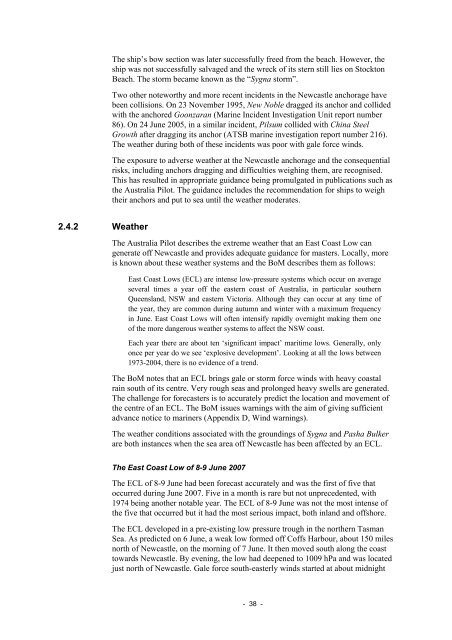Pasha Bulker 243 - Independent investigation into the grounding of ...
Pasha Bulker 243 - Independent investigation into the grounding of ...
Pasha Bulker 243 - Independent investigation into the grounding of ...
You also want an ePaper? Increase the reach of your titles
YUMPU automatically turns print PDFs into web optimized ePapers that Google loves.
The ship’s bow section was later successfully freed from <strong>the</strong> beach. However, <strong>the</strong><br />
ship was not successfully salvaged and <strong>the</strong> wreck <strong>of</strong> its stern still lies on Stockton<br />
Beach. The storm became known as <strong>the</strong> “Sygna storm”.<br />
Two o<strong>the</strong>r noteworthy and more recent incidents in <strong>the</strong> Newcastle anchorage have<br />
been collisions. On 23 November 1995, New Noble dragged its anchor and collided<br />
with <strong>the</strong> anchored Goonzaran (Marine Incident Investigation Unit report number<br />
86). On 24 June 2005, in a similar incident, Pilsum collided with China Steel<br />
Growth after dragging its anchor (ATSB marine <strong>investigation</strong> report number 216).<br />
The wea<strong>the</strong>r during both <strong>of</strong> <strong>the</strong>se incidents was poor with gale force winds.<br />
The exposure to adverse wea<strong>the</strong>r at <strong>the</strong> Newcastle anchorage and <strong>the</strong> consequential<br />
risks, including anchors dragging and difficulties weighing <strong>the</strong>m, are recognised.<br />
This has resulted in appropriate guidance being promulgated in publications such as<br />
<strong>the</strong> Australia Pilot. The guidance includes <strong>the</strong> recommendation for ships to weigh<br />
<strong>the</strong>ir anchors and put to sea until <strong>the</strong> wea<strong>the</strong>r moderates.<br />
2.4.2 Wea<strong>the</strong>r<br />
The Australia Pilot describes <strong>the</strong> extreme wea<strong>the</strong>r that an East Coast Low can<br />
generate <strong>of</strong>f Newcastle and provides adequate guidance for masters. Locally, more<br />
is known about <strong>the</strong>se wea<strong>the</strong>r systems and <strong>the</strong> BoM describes <strong>the</strong>m as follows:<br />
East Coast Lows (ECL) are intense low-pressure systems which occur on average<br />
several times a year <strong>of</strong>f <strong>the</strong> eastern coast <strong>of</strong> Australia, in particular sou<strong>the</strong>rn<br />
Queensland, NSW and eastern Victoria. Although <strong>the</strong>y can occur at any time <strong>of</strong><br />
<strong>the</strong> year, <strong>the</strong>y are common during autumn and winter with a maximum frequency<br />
in June. East Coast Lows will <strong>of</strong>ten intensify rapidly overnight making <strong>the</strong>m one<br />
<strong>of</strong> <strong>the</strong> more dangerous wea<strong>the</strong>r systems to affect <strong>the</strong> NSW coast.<br />
Each year <strong>the</strong>re are about ten ‘significant impact’ maritime lows. Generally, only<br />
once per year do we see ‘explosive development’. Looking at all <strong>the</strong> lows between<br />
1973-2004, <strong>the</strong>re is no evidence <strong>of</strong> a trend.<br />
The BoM notes that an ECL brings gale or storm force winds with heavy coastal<br />
rain south <strong>of</strong> its centre. Very rough seas and prolonged heavy swells are generated.<br />
The challenge for forecasters is to accurately predict <strong>the</strong> location and movement <strong>of</strong><br />
<strong>the</strong> centre <strong>of</strong> an ECL. The BoM issues warnings with <strong>the</strong> aim <strong>of</strong> giving sufficient<br />
advance notice to mariners (Appendix D, Wind warnings).<br />
The wea<strong>the</strong>r conditions associated with <strong>the</strong> <strong>grounding</strong>s <strong>of</strong> Sygna and <strong>Pasha</strong> <strong>Bulker</strong><br />
are both instances when <strong>the</strong> sea area <strong>of</strong>f Newcastle has been affected by an ECL.<br />
The East Coast Low <strong>of</strong> 8-9 June 2007<br />
The ECL <strong>of</strong> 8-9 June had been forecast accurately and was <strong>the</strong> first <strong>of</strong> five that<br />
occurred during June 2007. Five in a month is rare but not unprecedented, with<br />
1974 being ano<strong>the</strong>r notable year. The ECL <strong>of</strong> 8-9 June was not <strong>the</strong> most intense <strong>of</strong><br />
<strong>the</strong> five that occurred but it had <strong>the</strong> most serious impact, both inland and <strong>of</strong>fshore.<br />
The ECL developed in a pre-existing low pressure trough in <strong>the</strong> nor<strong>the</strong>rn Tasman<br />
Sea. As predicted on 6 June, a weak low formed <strong>of</strong>f C<strong>of</strong>fs Harbour, about 150 miles<br />
north <strong>of</strong> Newcastle, on <strong>the</strong> morning <strong>of</strong> 7 June. It <strong>the</strong>n moved south along <strong>the</strong> coast<br />
towards Newcastle. By evening, <strong>the</strong> low had deepened to 1009 hPa and was located<br />
just north <strong>of</strong> Newcastle. Gale force south-easterly winds started at about midnight<br />
- 38 -
















